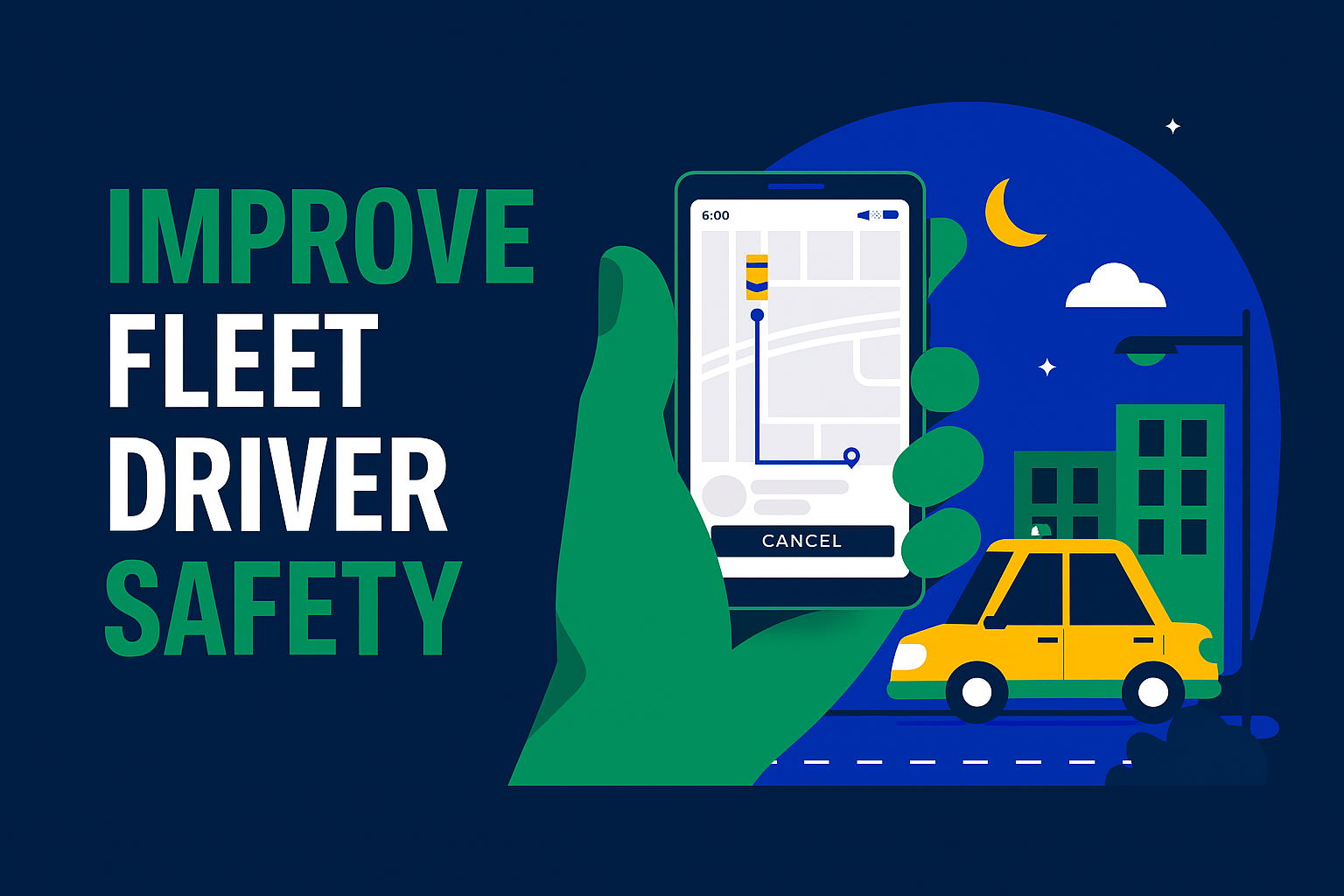5 Ways to Improve Driver Safety with Advanced Fleet Tracking
5 Ways to Improve Driver Safety with Advanced Fleet Tracking
Looking to improve driver safety in your fleet operations? You’re in the right place! As transportation continues to power the global economy such as moving people, goods, and essential services, driver safety has never been more critical.
Yet, road crashes are on the rise, with human error responsible for a staggering 94% of incidents, according to recent studies.
To stay competitive and avoid costly disruptions, businesses must prioritize proactive safety measures. That’s where advanced fleet tracking comes in as a powerful solution that empowers fleets of all sizes to monitor, manage, and improve driver behavior in real-time.
In this blog, we will explore expert-backed strategies and modern fleet safety solutions that can help you significantly improve driver safety and enhance overall operational efficiency.
Let’s get started!
Table of Contents
· The Importance of Using Vehicle Technology to Improve Fleet Driver Safety
· 5 Smart Strategies for Increasing Fleet Driver Safety in Saudi Arabia
· The Strategic Benefits of Prioritizing Driver Safety
· Choosing the Right Fleet Driver Safety Solutions in Saudi Arabia
· Protect Your Drivers and Your Bottom line with AFAQY’s Fleet Safety Solutions
The Importance of Using Vehicle Technology to Improve Driver Safety
.png)
Before exploring how fleet tracking solutions enhance driver safety, it's important to first understand what they are. Fleet tracking technology combines software and hardware to monitor vehicles in real-time, optimize routes, schedule maintenance, and track driver behavior.
When it comes to driver safety, these solutions are a game-changer, helping reduce risks, improve performance, and ensure smoother, more reliable fleet operations.
A recent case study on an Illinois fleet showed that after implementing an integrated driver management platform, accidents per driver dropped by 52% and injuries by over 26%, even with a 59% increase in drivers, proving the impact of data-driven safety solutions.
Here are some the ways fleet tracking technology can help in improving drivers’ behaviors and hence keep them safe:
Real-time Vehicle Tracking
According to NHTSA, bad driving habits such as speeding contributed to more than 29% of all the traffic fatalities in 2023.
With an advanced fleet tracking system, you can monitor driver behavior in real time, from speeding and harsh braking analysis to sudden turns and unauthorized stops. Instant alerts notify drivers of unsafe actions as they happen, helping them correct their behavior on the spot.
This proactive approach not only enhances driver safety but also reduces the risk of accidents and the costly consequences that may follow.
Video Telematics and Dashcams
Using a fleet tracking system that seamlessly integrates with video telematics and dashcams is crucial to solidify the safety of your fleet.
Habits such as distracted driving, tailgating, eating, or using cell phones during driving, all can be spotted using AI-powered cameras. This way, you can identify risky behaviors and take the needed corrective actions to improve safety and prevent any possible crashes or accidents and boost fleet efficiency.
Road Optimization
By leveraging data-driven insights provided by fleet tracking systems, you can optimize roads and promote a safer transportation environment.
Cutting-edge technologies can provide you with valuable insights into road congestion, traffic flow, and other real-time conditions. Congested areas are always linked to road accidents due to stop-and-go traffic and reduced visibility.
Dynamic road optimization also helps you reduce driver fatigue by allowing them to take shorter trips away from traffic, especially during night shifts and peak seasons.
Driver Scorecards and Safety Tools
Using performance evaluation tools such as driver scorecards and safety alerts in telematics systems is also an effective means to assess drivers’ behaviors and identify areas for improvement.
Driver scorecards use data from GPS systems to track speeding, harsh braking, or idling. This enables fleet managers to address risky behaviors through the necessary training programs and coaching.
They can also be used to reward and incentivize drivers who follow the safe driving policy based on predefined metrics.
Predictive Maintenance
According to an article titled: “Enhancing Reliability of Advanced Driver-Assistance Systems through Predictive Maintenance and Data-Driven Insights”, Gradient Boosting accurately predicted Advanced Driver-Assistance Systems (ADAS) failures with 93% accuracy and 94% precision, showing that machine learning-based predictive maintenance can greatly improve vehicle safety and reliability.
Thus, fleet management systems provided with an AI-powered predictive maintenance feature enhances driver safety by proactively identifying potential vehicle issues before sudden breakdowns happen.
By monitoring vehicle health in real-time and notifying fleet managers for timely maintenance and repairs, accidents caused by brake failures, tire issues, or engine problems can be highly mitigated.
5 Smart Strategies for Increasing Fleet Driver Safety in Saudi Arabia

Ensuring driver safety is a top priority for fleet managers in Saudi Arabia, especially with the growing demand for efficient, compliant, and technology-driven operations and to align with Vision 2030 fleet safety initiatives. Here are 5 smart strategies to help you enhance fleet driver safety and reduce risks on the road:
1. Implementing Robust Driver Training Initiatives
Even if highly qualified drivers are hired within your fleet, you still need to provide them with the appropriate training sessions to educate them on the right and safe driving habits.
Handling distractions, preventing speeding, and executing safe maneuvers are all equally important for drivers to learn to prevent vehicle crashes and ensure the safety of their fleet operations.
2. Enforcing Structured Safety Protocols
Enforcing rigorous safety policies is key to maintaining a safe-driving culture across your entire fleet. Such policies should offer specific direction on key matters such as the prevention of distracted driving, seatbelt use, and speeding.
By setting clear expectations and punishing drivers for failing to comply, companies can reduce the incidence of accidents, largely attain regulatory compliance, and protect their drivers and assets.
A well-crafted safety policy is not a list of do's and don'ts; it's the foundation of long-term operational effectiveness and safety.
3. Using a Driver Monitoring System
By using advanced GPS tracking, you can monitor driver behavior in real-time and notify them in case of any violations of the policy you’ve already set for them.
Fleet tracking systems extract instant fleet data from GPS devices and turn them into data-driven insights that you can use to take the rights actions. This helps you ensure the efficiency of your fleet operations, prevent accidents, and keep your vehicles and drivers safe most of the time.
4. Supporting Honest and Open Conversations
Encourage drivers to communicate openly with fleet managers and share any concerns or challenges they encounter on the road. This proactive approach helps identify and resolve issues early, protecting driver safety and ensuring smooth, uninterrupted fleet operations.
5. Leveraging Driver Safety Fleet Tracking Solutions
As explained above, fleet tracking systems that include driver monitoring and performance evaluation tools and predictive maintenance features offer a plethora of benefits for fleet managers and operators.
They help detect unsafe driving behaviors and send instant alerts to drivers so that they can correct their behavior and follow the right instructions.
Moreover, predictive maintenance enables you to set periodic maintenance schedules for vehicles to avoid any malfunctions or downtime.
The Strategic Benefits of Prioritizing Driver Safety
Enhancing driver safety within your fleet is not only important for the lives of your staff or your fleet health, but also to stay compliant, reduce costs, and boost your ROI.
Let’s highlight some of the strategic benefits of fostering a safe driving culture:
Reduced Costs
Indeed, fewer accidents mean not only saved lives but also reduced operational costs. By performing regular maintenance checks and monitoring driver behavior in real-time, you can both eliminate accidents and reduce the costs related to them.
Also, as part of fleet safety procedures, monitoring fuel consumption and directing drivers in case of any excessive or unauthorized fuel usage plays a crucial role in saving fleet costs.
What is more? Reduced accident rates can lead to increased insurance savings for the company and minimize the likelihood of employee injuries, leading to fewer workers' compensation claims.
Improved Brand Reputation
Prioritizing driver safety enhances your brand image by highlighting your dedication to employee welfare. It reflects your commitment to safe, responsible business practices.
A strong reputation for safety can attract top talent, appeal to major investors, and build trust with customers.
Fleet Safety Compliance
Fostering a safe driving environment is important not only to reduce accidents in fleets and enhance efficiency but also to stay compliant with the kingdom's regulatory standards and align with the goals of Vision 2030.
Choosing the Right Fleet Driver Safety Solutions in Saudi Arabia
To select the right driver safety solutions in KSA, follow these tips to achieve the results you’re aiming for:
· Define Your Needs: Consider factors such as the type of business, the size of your fleet, and the types of driving environments your vehicles operate in.
· Evaluate Available Solutions: Make sure that the solution covers your business needs to avoid unnecessary purchases. An effective driver safety system integrates telematics, video monitoring, and driver behavior analysis reporting.
· Assess Vendor Reputation: Check the experience of fleet solutions’ service provider to ensure that the company has a track record in the Saudi market. Also, research reviews and testimonials from other fleet operators and assess its support, such as response times and availability.
· Consider Cost & Implementation: Compare the costs of different solutions, including hardware, software, and ongoing fees. Additionally, find out about installation requirements and the level of training needed for your drivers.
Protect Your Drivers and Your Bottom line with AFAQY’s Fleet Safety Solutions
AFAQY’s fleet driver safety solutions empower you to monitor driver behavior in real time, reduce preventable accidents, and make smarter, data-driven decisions.
Whether you're managing a small fleet or scaling rapidly, AFAQY gives you the tools to enhance safety, cut costs, and stay compliant, without compromising efficiency.
Simply, tell us your business needs, and we’ll tailor our solutions to fit. Be it advanced telematics, integrated video surveillance, or cutting-edge driver analysis tools, we’ve got every aspect of your fleet safety covered.
Take control of your fleet’s future and talk to our experts today!
FAQs
1. How does fleet tracking improve driver safety?
It provides real-time insights into driver's behavior, enabling prompt corrections and safer driving practices.
2. What is driver behavior monitoring?
It’s the use of technology to track and analyze how drivers operate vehicles such as speeding, harsh braking, or rapid acceleration.
3. What are driver scorecards in fleet management?
They are performance reports that rate drivers based on safety metrics, helping identify top performers and those needing improvement.
4. How to reduce road accidents in my fleet?
Use telematics, monitor driver behavior, offer training, and implement safety-focused policies and technology like driver speeding alerts and scorecards.
References
1. Zero deaths and safe system. (n.d.). FHWA. https://highways.dot.gov/safety/zero-deaths
2. Speeding| NHTSA. (n.d.). NHTSA. https://www.nhtsa.gov/risky-driving/speeding#:~:text=Dangers%20of%20Speeding,-TRAFFIC%20SAFETY%20FACTS&text=For%20more%20than%20two%20decades,29%25%20of%20all%20traffic%20fatalities
3. Adanu, E. K., Dzinyela, R., Okafor, S., & Jones, S. (2024). Injury-severity analysis of crashes involving defective vehicles and accounting for the underlying socioeconomic mediators. Heliyon, 10(5), e26944. https://doi.org/10.1016/j.heliyon.2024.e26944
4. D & Apos; Angelo, M. (2024, October 15). How Telematics improves driver safety. Business NewsDaily.https://www.businessnewsdaily.com/fleet-tracking/telematics-improves-driver-safety



































.png)


